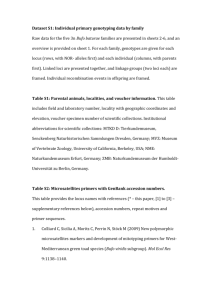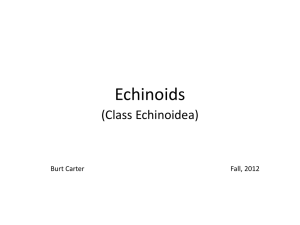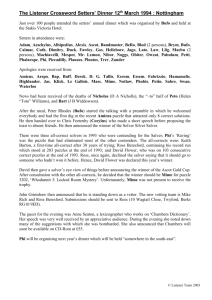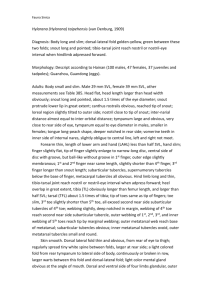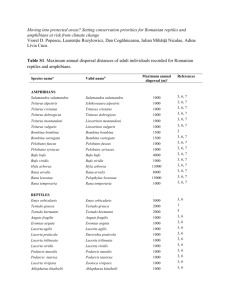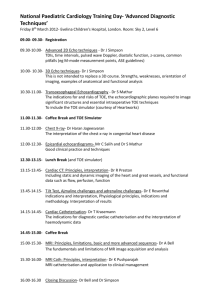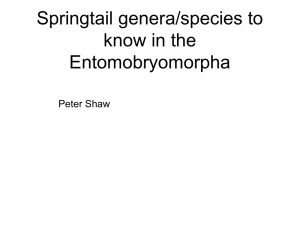introduction - Wildlife of Pakistan
advertisement
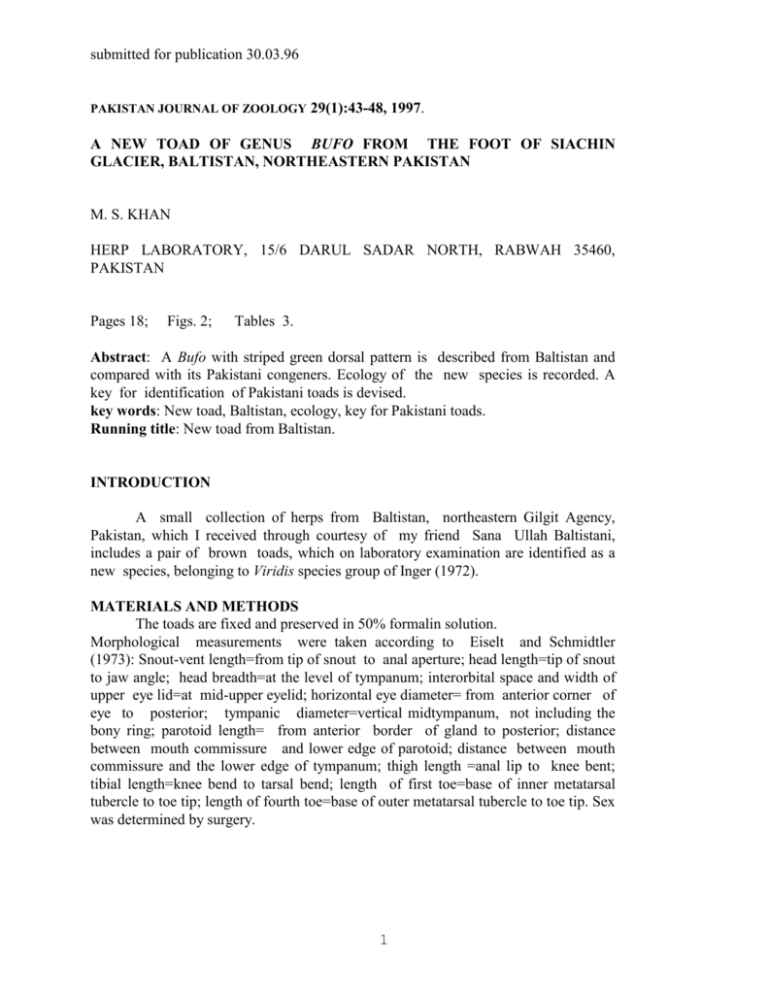
submitted for publication 30.03.96
PAKISTAN JOURNAL OF ZOOLOGY
29(1):43-48, 1997.
A NEW TOAD OF GENUS BUFO FROM THE FOOT OF SIACHIN
GLACIER, BALTISTAN, NORTHEASTERN PAKISTAN
M. S. KHAN
HERP LABORATORY, 15/6 DARUL SADAR NORTH, RABWAH 35460,
PAKISTAN
Pages 18;
Figs. 2;
Tables 3.
Abstract: A Bufo with striped green dorsal pattern is described from Baltistan and
compared with its Pakistani congeners. Ecology of the new species is recorded. A
key for identification of Pakistani toads is devised.
key words: New toad, Baltistan, ecology, key for Pakistani toads.
Running title: New toad from Baltistan.
INTRODUCTION
A small collection of herps from Baltistan, northeastern Gilgit Agency,
Pakistan, which I received through courtesy of my friend Sana Ullah Baltistani,
includes a pair of brown toads, which on laboratory examination are identified as a
new species, belonging to Viridis species group of Inger (1972).
MATERIALS AND METHODS
The toads are fixed and preserved in 50% formalin solution.
Morphological measurements were taken according to Eiselt and Schmidtler
(1973): Snout-vent length=from tip of snout to anal aperture; head length=tip of snout
to jaw angle; head breadth=at the level of tympanum; interorbital space and width of
upper eye lid=at mid-upper eyelid; horizontal eye diameter= from anterior corner of
eye to posterior; tympanic diameter=vertical midtympanum, not including the
bony ring; parotoid length= from anterior border of gland to posterior; distance
between mouth commissure and lower edge of parotoid; distance between mouth
commissure and the lower edge of tympanum; thigh length =anal lip to knee bent;
tibial length=knee bend to tarsal bend; length of first toe=base of inner metatarsal
tubercle to toe tip; length of fourth toe=base of outer metatarsal tubercle to toe tip. Sex
was determined by surgery.
1
BMNH=British Museum (Natural History), London; MSK=Personnel
collection of author, Herp Laboratory, 15/6 Darul Sadar North, Rabwah 35460,
Pakistan.
Bufo siacheninsis new species
(Fig.1)
Holotype: BMNH 1990.94 (MSK 026.94), gravid female, from seepage pools close
to Shinu village, on the left bank of River Shyok, 140 km east of Skardu, at the foot
of Siachen Glacier, Baltistan, northeastern Pakistan, 76.650 E, 35.250 N, elevation
5238 m from sea level, collector Sana Ullah Baltistani, 10th August, 1994.
Paratype (1): MSK 027.94, data as for holotype.
Diagnosis: Medium size Bufo with six dark-green stripes on light dorsum; first two
fingers subequal; single subarticular tubercle under fingers and toes; tip of fourth
finger extends beyond the base of terminal phalanx of third finger; no tarsal fold;
parotoids narrow, about twice as long as broad; distinct ulnar, tibial and tarsal
glands; dorsum smooth with low smooth nonspinulated tubercles; limbs blotched
with green; ventrum marbled, with dark spots all over; tips of digits slightly
swollen, white.
Description of holotype (all measurements in mm): BMNH 1990.94, a gravid female,
snout-vent length 61.15; head almost as long (22) as broad (21.7), upper jaw
protruded over lower jaw. Canthus rostralis obtuse, loreals oblique sloping
outwards, slightly concave in the middle, snout rounded (in lateral profile),
dorsally flat and smooth. Naris much closer to snout tip (1.8) than eye (4.0), slightly
swollen, facing upwards and backwards, just below canthus. Upper eyelid longer
(6.7) than broad (5.9), with smooth tubercles at its posterior half, interorbital space
flat, narrower (3.9) than upper eyelid (5.9) with numerous smooth minute tubercles.
Tympanum round, its vertical diameter (2.55) about half the horizontal diameter
(5.75) of eye, slightly covered from behind by parotoid. Parotoids raised,
smooth, pitted, elongated pear-shaped, anterior end broadest, much longer (13.4)
than broad (8.5), abutting against upper eyelid, partially covering tympanum from
behind, posterior pointed end extending to the level of axilla. Dorsal border of
parotoids not clearly marked, a patch of sub-parotoidal tubercles. Inter-parotoid
space tuberculated. A pair of tubercles at the corner of mouth.
Body dorsum slightly raised, gradually sloping on sides of bulging belly,
dorsum varicose with smooth
scattered heterogeneous tubercles, largest
haphazardly scattered among smaller ones, a distinct row of large tubercles along
lateral sides of the belly, largest tubercle as large as tympanum, smaller
heterogeneous tubercles scattered unevenly on dorsum and ventrum. A crescentric row
of subcloacal tubercles.
Anterior limb moderate, fore-arm distinctly thicker than upper-arm, an
elongated ulnar gland along outer border of fore-arm; a groove between fore-arm and
hand on upper side. Fingers flattened with distinct lateral dermal border, tips
round, slightly swollen. First finger slightly smaller than second, a large subdigital
tubercle between first and second phalanx. Distal two phalanges of the first finger
are bent inward and have thick dermal border. Second and third fingers are
narrower, with single subdigital tubercles, the fourth finger has a pair of tubercles
2
between first-second and second-third phalanx. Tip of fourth finger extends to the
level of the base of the distal phalanx of the third finger. Fingers are 3,4,2,1 when
arranged in order of reduction in size. The palm is varicose with few smooth
tubercles. Outer metacarple tubercle large, protuberant, triangular to round, larger
than tympanum; inner tubercle oval, placed on the inner side of the basal phalanx
of the first finger.
Posterior limbs strong, when limb is adpressed against body the tibiotarsal
articulation reaches to the midbody, and the tip of fourth toe to a point between eye
and nostril; when thighs are bent at right angle to the body the heels are kept apart by
the coccyxal width, ; thigh are longer and thicker than tibia, dorsally varicose with
scattered tiny tubercles; tibia as long as breadth of head, with a smooth tibial gland
on its outer surface. Tarsus as broad as thigh, with tarsal gland on its inner surface, 23 rows of smooth sub-tarsal tubercles. A pair of metatarsal tubercles, outer slightly
raised rounded area, as big as inner metacarple tubercle, while inner elongated lying
under dermal border of the inner toe; toes flat lined with broad dermal border which
does not include the toe tips. Fourth toe with broad dermal border, nicked at joints;
web reaching to the base of second phalanx of fourth toe; subdigital toe tubercles
smaller than those under fingers, sole with few smooth tubercles.
Colour: Body leathery brown (in formalin preserved material) visible in interstripe areas. Six dark green stripes form the dorsal pattern: an epi-parotoidal stripe,
on each side, running from snout, upper eyelid, along upper border of parotoids to the
coccal sides. These stripes are joined by a transverse mid-parotoid band; a subparotoid stripe, on each side, starting from snout running along lower border of
parotoid to inguinal region. The third is a broad abdominal stripe, running from
tympanum, on each side, shoulder, latero-ventrum of abdomen, where it is broken
in dark specks which are more concentrated under thighs and posterior part of
abdomen, continuing mesially and laterally to chest, chin and under hind limbs.
Crown with few elongated green blotches on upper lip, snout upper eyelid.
Dorsally limbs are with large green blotches. Finger and toe tips white.
Variations: Table 1 summarizes morphological differences between type
series. Both toads are gravid females. Type specimen is larger in snout-vent
length, head length, has longer and broader parotoids and lighter ground body colour.
However, paratype is more darker brown, its tarsometatarsal articulation reaches to
mid-parotoids, tip of fourth toe extends well beyond snout, both have similar ventral
body pattern.
Ecology: The new species was collected from small seepage puddles along sides of
terraced cultivated fields on the southern bank of Shyok River, near Shinu village. The
puddles were surrounded by moderately thick grass, with no emergent vegetation.
No other amphibian or reptile was collected from the site, however, from the nearest
rocks several specimens of Agama himalayana and from houses of Shinu village
Tenuidactylus baturensis Khan and Baig, 1992 were collected.
Baltistan is a high altitude (2300 m) cold desert lying in the north of State
of Jammu & Kashmir. Karakoram glaciers Baltoro, Concordia, Kaberi, Kandus and
Siachen lie in the East demarcating border with China. Desolate Deosai Plateau
forms its western border. Several torrents drain glaciers into River Shyok which
ultimately joins the River Indus (Adamson and Shaw, 1981).
3
High altitude snowy desertic conditions and hard stony soil, low temperature
(summer 57-85oF, winter 32-500F) and low annual precipitation (Ahmad, 1989),
support little natural vegetation of type of sparse grass and thorny bushes,. However,
fruit orchards and other cash crops are grown wherever water is available, mostly
along sides of water ways, in carefully tended terraced fields.
During short lived hot summer (May-August), several arthropods are
common in the area, attracting toads (reported in this paper), gecko Tenuidactylus
baturensis Khan and Baig, 1992 and an agamid Agama himalayan collected from
nearby settlements and rocks respectively. The short lived summer is utilized by
these animals for reproductive activity.
Comparison with congeners: Pakistani highland broad-skulled toads Bufo
himalayanus (Gunther, 1864) and B. melanostictus Schneider, 1801, are well
distinguished from the new species B. siacheninsis by their cranial crests, cornified
asperities on fingers and toes and large coarser warts on body dorsum. While
highland narrow-skulled toads B.viridis Lauranti, 1768, B. raddei Strauch, 1876,
and B. latastei Boulenger, 1882, are morphologically very close to each other and
are diagnosed on apparently minor but consistent characters (Inger, 1972). Though
latastei has a tarsal gland, longitudinal parotoid and narrower interorbital space like
siacheninsis but it differs from it due to its wortier dorsum, presence of a distinct
tarsal fold, first finger longer than second and presence of double subarticular
tubercles under fingers and toes and dorsal pattern of small spots.
Table 2 and 3 compare the new toads from Pakistani species of Viridis
Group:apart of the compared characters dorsum of B. viridis is smooth, granulated
to warty, like siacheninsis lateral abdominal tubercles are arranged in longitudinal
rows, elongate parotoids, presence of tarsal gland, subarticular tubercles are
rarely double, dorsal pattern is very variable from unicolour gray to beige-dark with a
light vertebral stripe, while digital tips are light. Recently described B. v.
pseudoraddei Mertens, 1971 differs from siacheninsis in its larger size (SVL 5572 mm), has double subarticular tubercles under fingers which are dark or light
tipped, inner metacarple tubercle is equal or smaller than 1/3rd of outer, while light
dorsum is heavily reticulated with dark green with a distinct light middorsal stripe.
This race has been described from northwest of North Western Frontier Province.
The second race B. v. zugmayeri Eiselt and Schmidtler, 1973, is distinguished by its
distinctly downward projected parotoids, wider interorbital space, longer first
finger, double subarticular tubercles under 4th toe, distinct tarsal ridge, spotty dorsal
pattern of green, spots are usually smaller than eye. This race has recently been
described from Balochistan highland. On the other hand the extralimital Siberian
toad B. raddei is distinguished from the new species by its distinct tarsal fold,
double subarticular tubercles, broader web along fourth toe, dorsal pattern of green
blotches or spots which are often larger than eye (Fig. C, Plate 8, Zhao and Adler,
1993) or green dorsal reticulation (Liu, 1936:Plate III, Figs.1-5), and the habitat
preference, which is stated to be "driest where no other amphibian is able to exist",
(Pope, 1931; Pope and Boring, 1941).
The toads of plains of Pakistani: B. stomaticus Lutken, 1863 and B. olivaceus
Blanford, 1874, are distinguished from the new species B. siacheninsis by their
coarser, wortier, light brown body with light dark spotty pattern, absence of dermal
4
border along fingers and toes which are tipped black; parotoids are longer, broader
and kidney-shaped, a more or less distinct tarsal fold. The Iranian B. surdus
Boulenger, 1891 is distinguished by its indistinct tympanum, coarser dorsum, thinner
dermal border along fingers and toes and spinulated tarsal fold.
The new species B. siacheninsis is distinguished from all its Pakistani
congeners by following combination of characters: slightly protruding upper jaw
over mouth, dorsal six striped green pattern, narrower pear-shaped parotoids,
distinct ulnar, tibial and tarsal glands, single subarticular tubercles under fingers
and toes, absence of tarsal fold, softer dorsum with fewer low smooth tubercles,
dark blotched white belly with scattered small rounded granules, fingers and toes
with light tips.
Discussion: The new toad Bufo siacheninsis belongs to Inger's (1972) viridis Group,
which includes B. viridis, B. calamita, B. raddei, B. orientalis, B. latastii, and B.
surdus. Of which three toads B. calamita, B. raddei and B. orientalis, are
extralimital for Pakistan, while B. viridis is distinguished in four races: mainland
European race B. v. viridis Laurenti, 1768, mid-eastern B. v. arabicus Heyden, 1827.
While rest of the two races are described from Pakistan: from Swat, northwestern
Pakistan B. v. pseudoraddei Mertens, 1971; from south-western Balochistan B. v.
zugmayeri Eiselt and Schmidtler, 1973 (B. v. arabicus of Flint and Hemmer, 1968;
Mertens, 1969).
Dubois and Martens (1977) extensively collected B. latastii Boulenger, 1882
from Nepal, Ladakh, Kashmir and northern Indian Punjab. In earlier reports this
species has been identified as B. viridis (Steindachner, 1867; Stoliczka, 1872a;
Anderson, 1872; Schmidt, 1926; Angel, 1946; Kauri, 1948; Mertens and Wermuth,
1960; Murthy and Sharma, 1976; Duda and Sahi, 1977). While B. viridis of western
Xinjiang, China has recently been described as a new taxon B. danatensis Pisanets,
1978.
The two Pakistani races of Bufo viridis are confined along western highland
border of Pakistan. Reports of this species from Salt Range, Punjab, Pakistan (Hora
and Chopra, 1923) and Abbotabad, eastern North Western Frontier Province,
Pakistan (Stoliczka (1872b) are not confirmed by other collectors from the areas
(Rao, 1923; Mertens, 1969; Khan, 1979, 1986; Khan and Baig, 1992). From Salt
Range only B. stomaticus is collected, while in Abbotabad B. stomaticus and B.
melanostictus are extensively collected without trace of B. viridis.
Mertens (1969) regards B. v. pseudoraddei as an intergrade between B. v.
zugmayeri (=arabicus) and B. raddei, however, B. siacheninsis is a distinct species
with unique morphology. It adds eighth toad to the list of seven already known
toads from Pakistan (Khan, 1994; Khan and Tasnim, 1987).
Pakistani toads are distinguished from each other by the following key:
1. Head with cranial crests.....................2
Head without cranial crests..................3
2. Only supra orbital crest present;
tympanum indistinct........................B. himalayanus
Canthal, supraorbital, postorbital
5
and orbitotympanic crests present,
tympanum distinct...........................B. melanostictus
3. Tympanum distinct............................4
Tympanum indistinct...........................B. surdus
4. Tibial gland absent..........................5
Tibial gland present.........................6
5. Dorsum with green pattern....................7
Dorsum uniformly olive.................B. olivaceus
6. Tarsal fold indicated by a weak
spinulated line........................B. stomaticus
A distinct tarsal fold present...........B. latastei
7. Dorsal pattern of scattered
green spots..............................B. v. zugmayeri
Dorsal pattern of coalaced green
blotches.....................................8
8. Dorsal pattern of longitudinal
stripes, three on each side............B. siacheninsis
Dorsum heavily green with occasional light
spots of original body colour.........B. v. pseudoraddei
ACKNOWLEDGEMENT
Author wishes to thank Mr. Sana Ullah Baltistani for the collection of toads,
which made this study possible.
Author's thanks are also due to: Dr. Dr. E.M. Pisanets, Herpetological
Laboratory, Melitopol Teacher's Training College, Ukraine for gift of three
specimens of Bufo raddei from his collection for comparison; Drs. W. Ronald Heyer,
and George Zug, Smithsonian Institution, Washington, USA for providing pertinent
literature from their library.
My special thanks are for Malik Zubair Ahmed for translation of Russian and
German literature.
6
Legends to the figures
Fig. 1. Bufo siacheninsis new species, Holotype BMNH 1990.94 (MSK
026.94), dorsal view.
Fig.2. Baltistan, main glaciers and river system around type locality Shinu of new
species Bufo siacheninsis (A=Hispar and Biafo Glaciers; B=Baltoro Glacier;
C=Concardia and
Siachen Glaciers. Inset:Northeastern Pakistan and Baltistan,
shaded area enlarged.
Table 1. Morphometrics of type series of new species Bufo siacheninsis (all
measurements in mm).
________________________________________________________________
Character
Holotype BMNH 1990.94
MSK 027.94
________________________________________________________________
Sex
female
female
Snout-vent length
61.15
59.75
Head:
length
22
18.05
breadth
21.7
21.6
Snout length
6.9
6.1
Naris to eye
4.0
3.9
Snout tip to naris
1.8
2.2
Diameter of:
eye
5.75
5.75
ear
2.55
3.4
Parotoid gland:
length
13.4
11.75
breadth
8.5
6.6
Upper eyelid:
length
6.7
7.0
breadth
5.9
5.0
Interorbital space
4.2
4.3
Internarial space
3.9
3.7
Eye-tympanum space
1.6
1.85
Tympanum-mouth commissure space 2.6
2.15
Parotoid-mouth commissure space
5.95
5.3
Eye-mouth commissure space
4.0
4.05
Carple tubercle:
7
outer, horizontal length
3.6
3.4
inner, length
2.9
2.3
Length of:
thigh
23.0
22.1
Tibia
21.3
19.7
Tibial breadth
7.6
7.2
1st toe
8.9
6.3
4th toe
24.8
23.0
metatarsal tubercle
inner
3.9
3.9
outer
3.5
2.4
________________________________________________________________
Table 2. Comparison of Bufo siacheninsis with B. raddei and B. viridis. Data,
except for B. siacheninsis, from Eiselt and Schmidtler, 1973 (only animals over
SVL 40 mm considered).
A= comparative size of first two fingers; B=number of subarticular tubercles
under fingers (i=single, ii=paired); C= protruberance of inner/outer metatarsal
tubercle; D=presence of outer metatarsal tubercle; E=colour of digital tips (-=absent;
+=present).
________________________________________________________________
A
B
I>II I<II i
C
ii
D
E
<1/3 >1/3
+
- light dark
_________________________________________________________________
B. siacheninsis (n=2)
0 2
0
2
2 0 2 0 2
0
_________________________________________________________________
B. viridis pseudoraddei (n=9)
8
5 4
1
8
4 5 9 0 6
3
_________________________________________________________________
B. raddei (n=8)
2
6
8
0
8
0
0
8
0
8
________________________________________________________________
Table 3. Morphometric comparison of new species Bufo siacheninsis with Bufo v.
pseudoraddei Mertens, 1971 (all measurements in mm).
_________________________________________________________________
Bufo siacheninsis Bufo v. pseudoraddei
_________________________________________________________________
Snout-vent length
53-61
55-72
Snout-vent/tibial
2.7-2.8
2.47-2.62
Snout projected
+
Snout/eye diameter longer than eye dia
smaller
Snout-naris/
naris-eye
twice longer
twice longer
Eye/tympanic
diameter
1.6-2.25
0.40
9
Inner/outer carple
tubercle
less than half
half
Tarsometatarsal
joint to
midbody
tympanum
Tarsal fold
+
Parotoid length/
breadth
twice longer
little longer
Inner metatarsal tubercle
length /outer
equal
little smaller
Presence of
ulnar gland
+
tibial gland
+
tarsal gland
+
Mid-dorsal light line broad
narrow
Tubercle on dorsum
fewer
many
Colour of dorsum
brown
light gray
Dorsal pattern
striped
dark, spotted
Belly
marbled, with dark spots light, rarely spotted
________________________________________________________________
Literature cited
Adamson, H., and I. Shaw, 1981. A traveller's Guide to Pakistan. Asian Study Group,
P.O. Box No. 1532, Islamabad.
Ahmad, K. S. 1989. Climate regions of West Pakistan. Pakistan Geo. Rev., 6(1):1135.
Anderson. J. 1871. A list of the Reptilian accession to the Indian museum,
Calcutta, from 1865 to 1870, with a description of some new species. J. Asiat. Soc.
Bengal, 40:12-39.
Anderson, J. 1872. On some Persian, Himalayan, and other reptiles. Proc. Zool.
Soc. London, 371-404.
Angel, F. 1946. Faune de France. 45. Reptiles et Amphibiens. Paris, Librairie de la
faculte des sciences, 1-204.
Dubois A., and J. Martens, 1977. Sur les crapauds du groupe de Bufo viridis
(Amphibiens, Anoures) de l'Himalaya Occidental (Cachemire et Ladakh). Bulletin
de la Societe Zoologique de France, 102:459-465.
Duda, P. L. and D. N. Sahi, 1977. An uptodate checklist of herpetiles of Jammu
and Kashmir. University Review, 6:1-7.
10
Eiselt, V. J. and Schmidtler, J. F. 1973. Froschlurche aus dem Iran unter
Berucksichtigung auBeriranischer Populationsgruppen. Ann. Naturhistor. Mus. Wien.,
77:181-243.
Flindt, R. and H. Hemmer, 1968. Uber Bufo viridis
Senckenbergiana biology, 49:99-106.
im
Vorderen Orient.
Hora, S. L., and B. Chopra, 1923. Reptilia and Batrachia of the Salt Range, Punjab.
Records of Indian Museum, 25:369-376.
Inger, R.F. 1972. Bufo of Eurasia. In:Evolution in the genus Bufo. W.F. Blair
(Edt.) University of Texas Press, Austin, PP:102-118.
Kauri, H. 1948. Ueber die Ausbreitung und die Ausbreitungsumstande
der Wechselkrote (Bufo viridis Laur.) im Ostseegebiet. Lunds Universitat Arsskrift,
N.F., 44:1-30.
Khan, M. S. 1979. On a collection of amphibians from northern Punjab and
Azad Kashmir, with ecological notes. Biologia (Lahore), 25:37-50.
Khan, M. S. 1986. A noteworthy collection of amphibians and reptiles
northwestern Punjab, Pakistan. The Snake, 18:118-125.
from
Khan, M. S., and R. Tasnim, 1987. A field guide to the identification of herps
of Pakistan. Part I: Amphibia, Monograph No. 14. Biological Society of Pakistan,
Lahore, pp.1-27.
Liu, C. C. 1936. Secondary sex characters in Chinese frogs and toads. Field Mus. nat
hist., Zool. Ser., 22:115-156.
Mertens, R. 1969. Die Amphibien und
Beitrage zur Naturkunde, 197:1-96.
Reptilien
West-Pakistans. Stuttgarter
Mertens, R. 1971. Die Amphibiens und Reptilien West-Pakistans. 2. Nachtrag.
Senckenbergiana biology, 52:7-15.
Mertens, R. and H. Wermuth, 1960. Die Amphibien
Frankfurt, Walde. Kramer,:1-264.
und
Reptilien Europas.
Murthy, T.S.N. and B.D. Sharma, 1976. A contribution toi the herpetology
Jammu and Kashmir. British Journal of Herpetology, 5:533-538.
of
Pisanets, E.M. 1978 On a new polyploid species of Bufo danatensis Pisanetz, sp.n.,
from Turkmenistan. Dopovidi Akad. Nauk Ukrain. RSR, ser.B, Kiev, 1978:277-282
(in Russian).
11
Pope, C.H. 1931. Notes on amphibians from Fukien, Hainan, and other parts of
China. Bull. American Mus. Nat. Hist. 61:452-610.
Pope, C. H., and A. M. Boring, 1941. A survey of Chinese amphibia. Pecking
Nat. Hist. Mus. Bull., 15:30-83.
Rao, C.R.N. 1923. Notes on a collection of Batrachia from S. Waziristan. Jour.
Bombay Nat. Hist. Soc., 29:131-135.
Schmidt, K.P. 1926. Amphibians and reptiles of the James Simpson-Roosevelt Asiatic
expedition. Field Museum of Natural History Publication No. 237, 12:167-173.
Stoliczka, F. 1872a. Observation on some Indian and Malayan Amphibia and
Reptilia. Jour. Asiat. Soc. Bengal, 39:134-228.
Stoliczka, F. 1872b. Notes on some new species of Reptilia and Amphibia, collected
by Dr. W. Waagen in North-Western Panjab. Proc. Asiatic Soc. Bengal, 1872:124131.
Steindachner, F. 1867. Amphibien. Novara-Expedition, Zool. Theil, I:1-70.
Zhao, Er-Mi and K. Adler, 1993. Herpetology of China. Society for the Study of
Amphibiens and Reptiles, 1-522.
----:::::||||))))>>>>}}}}}]]]{{{{{{{((((((O<
12
Table 4.Morphological comparison of Bufo siacheninsis with Indo-Iranian toads
(data from specimens over 40mm).
A= B. siacheninsis; B= B. viridis; C=B. surdus; D=B. stomaticus; B. Olivaceus.
DLTR= dorsolatral rows of tubercles; ab=absent; F=finger;
gr=granulated;
long=longitudinal;
mo=mostly; PL=parotoid length; pr=present; PS=parotoid
shape; T=toe; wo=warty; ra=rare;
A
B
C
D
Snout extends
over mouth slightly never
Middorsum
DLTR
PS
gr
never
very often often
gr + wo gr + wo
pr
long
E
mo pr ab or ra
long
square
mostly gr smooth
ab
ab
long
long
PL/SVLx100 21.0-22.0 15.0-31.0 11.0-15.0 23.0-30.0 30.0-30.0
UEB/IOD
TD/ED
TF
1.2-1.3
1.2-1.3 0.9-1.3
0.8-1.1 0.7-1.0
0.47-0.53
0.2-0.5 0.0-0.2
0.5-0.7 0.5-0.7
smooth
ST-4 toe
Eyelid spots
smooth smooth granular weakly
granular
granular
sin sin rare sin rare
doub
doub
sing
sing
+ fused pattern
Dorsal colour brown,
with three
13
F/T tips
lig
lig
lig-br
bl
dark
14
